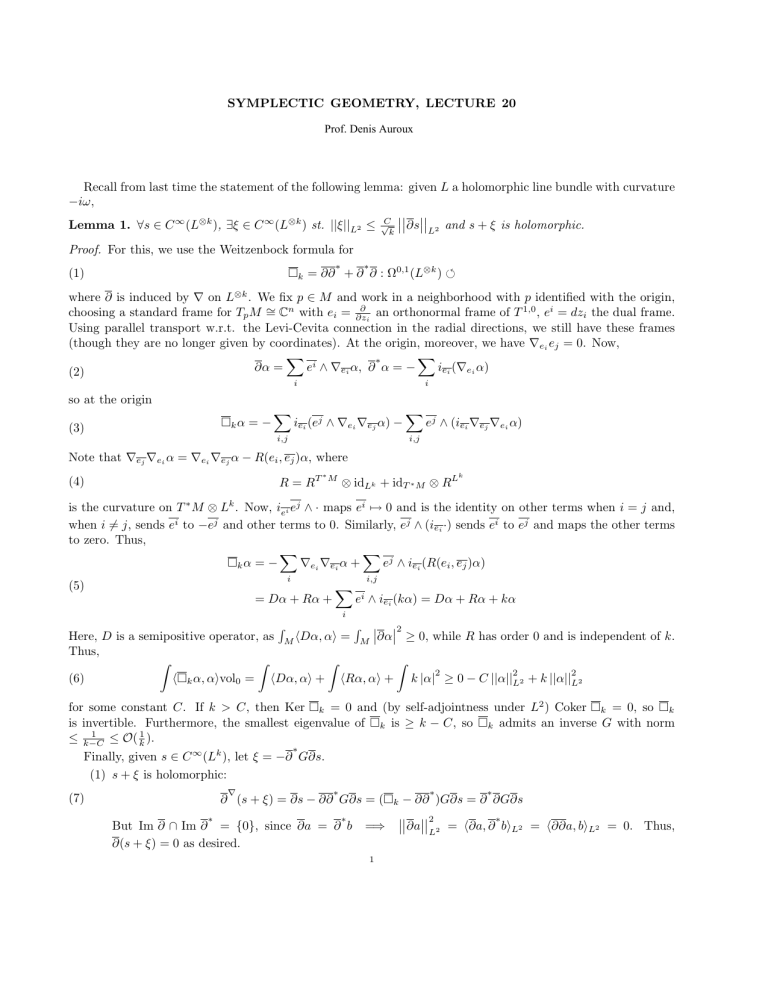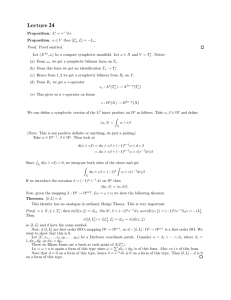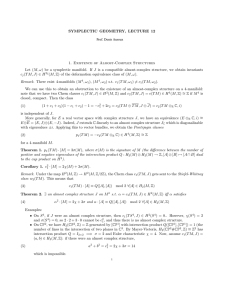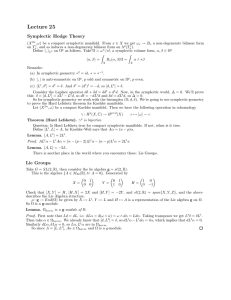SYMPLECTIC GEOMETRY, LECTURE 20
advertisement

SYMPLECTIC GEOMETRY, LECTURE 20
Prof. Denis Auroux
Recall from last time the statement of the following lemma: given L a holomorphic line bundle with curvature
−iω,
�� ��
Lemma 1. ∀s ∈ C ∞ (L⊗k ), ∃ξ ∈ C ∞ (L⊗k ) st. ||ξ||L2 ≤ √Ck ��∂s��L2 and s + ξ is holomorphic.
Proof. For this, we use the Weitzenbock formula for
∗
∗
�k = ∂∂ + ∂ ∂ : Ω0,1 (L⊗k ) �
(1)
where ∂ is induced by � on L⊗k . We fix p ∈ M and work in a neighborhood with p identified with the origin,
∂
an orthonormal frame of T 1,0 , ei = dzi the dual frame.
choosing a standard frame for Tp M ∼
= Cn with ei = ∂z
i
Using parallel transport w.r.t. the Levi-Cevita connection in the radial directions, we still have these frames
(though they are no longer given by coordinates). At the origin, moreover, we have �ei ej = 0. Now,
�
�
∗
∂α =
ei ∧ �ei α, ∂ α = −
iei (�ei α)
(2)
i
i
so at the origin
(3)
�k α = −
�
iei (ej ∧ �ei �ej α) −
i,j
�
ej ∧ (iei �ej �ei α)
i,j
Note that �ej �ei α = �ei �ej α − R(ei , ej )α, where
R = RT
(4)
∗
M
k
⊗ idLk + idT ∗ M ⊗ RL
is the curvature on T ∗ M ⊗ Lk . Now, iei ej ∧ · maps ei �→ 0 and is the identity on other terms when i = j and,
when i �= j, sends ei to −ej and other terms to 0. Similarly, ej ∧ (iei ·) sends ei to ej and maps the other terms
to zero. Thus,
�
�
�k α = −
�ei �ei α +
ej ∧ iei (R(ei , ej )α)
i
(5)
i,j
= Dα + Rα +
�
ei ∧ iei (kα) = Dα + Rα + kα
i
� � �2
Here, D is a semipositive operator, as M �Dα, α� = M �∂α� ≥ 0, while R has order 0 and is independent of k.
Thus,
�
�
�
�
2
2
2
(6)
��k α, α�vol0 = �Dα, α� + �Rα, α� + k |α| ≥ 0 − C ||α||L2 + k ||α||L2
�
for some constant C. If k > C, then Ker �k = 0 and (by self-adjointness under L2 ) Coker �k = 0, so �k
is invertible. Furthermore, the smallest eigenvalue of �k is ≥ k − C, so �k admits an inverse G with norm
≤ k−1C ≤ O( k1 ).
∗
Finally, given s ∈ C ∞ (Lk ), let ξ = −∂ G∂s.
(1) s + ξ is holomorphic:
(7)
�
∗
∗
∗
∂ (s + ξ) = ∂s − ∂∂ G∂s = (�k − ∂∂ )G∂s = ∂ ∂G∂s
�� ��2
∗
∗
∗
But Im ∂ ∩ Im ∂ = {0}, since ∂a = ∂ b =⇒ ��∂a��L2 = �∂a, ∂ b�L2 = �∂∂a, b�L2 = 0. Thus,
∂(s + ξ) = 0 as desired.
1
Prof. Denis Auroux
2
(8)
�� ��2
2
(2) ||ξ||L2 =≤ O( k1 ) ��∂s��L2 :
��
��2
∗
∗
∗
�� ∗
��
��∂ G∂s�� = �∂ G∂s, ∂ G∂s�L2 = �∂∂ G∂s, G∂s�L2
L2
�� ��2
1 �� ��2
= �∂s, G∂s�L2 ≤ ||G|| ��∂s��L2 ≤ O( ) ��∂s��L2
k
�
1. Counterexamples
We know now that K ahler =⇒ complex and symplectic, while both imply the existence of an almost-complex
structure, and the latter implies that the manifold is even-dimensional and orientable. In dimension 2, these
are all the same: in dimension 4, all these inclusions are strict (even when restricting to compact manifolds).
Example.
• S 4 is even-dimensional and orientable, but not almost-complex: if it were, c1 (T S 4 , J) ∈
2
4
H (S , Z) = 0 would satisfy c21 · [S 4 ] = 2c2 − p1 = 2χ + 3σ (with χ the Euler characteristic and σ the
signature), which is impossible. Similarly, CP2 #CP2 is not almost-complex:
∼ Z2 =⇒ c2 · [CP2 #CP2 ] = a2 + b2 �= 2χ + 3σ = 14
c1 = (a, b) ∈ H 2 =
(9)
1
which is again impossible.
• CP2 #CP2 #CP2 is almost-complex, but not symplectic or complex: Ehresman-Wu implies that ∃J with
c1 = c ∈ H 2 (M, Z) ⇔ c2 · [M ] = 2χ + 3σ and ∀x ∈ H2 , �c, x� ≡ Q(x, x) mod 2. In our case, χ = 5
and σ = 3, so the calculation works out. By the Kodaira classification of surfaces, if it were complex it
would be K¨ahler; by Taubes’ (1995) theorem on Seiberg-Witten invariants, it is not symplectic.
• The Hopf surface S 3 × S 1 ∼
= (C2 � {0})/Z is complex (Z-action (z1 , z2 ) �→ (λn z1 , λn z2 ) is holomorphic)
2
but not symplectic (H = 0).
• Not all symplectic manifolds have complex structure (compatible or otherwise). For the former case, we
have examples of torus bundles over tori; for the latter case, we have the following theorem.
Theorem 1 (Gompf 1994). ∀G finitely presented group, ∃M 4 compact, symplectic, but not complex
with π1 (M 4 ) ∼
= F.
This construction is obtained by performing symplectic sums along codimension 2 symplectic submanifolds. Since
(10)
H1 (M, Z) = Ab(π1 (M )) = Ab(G) = G/[G, G]
M is not K ahler if this has odd rank (since H 1 ∼
= H 1,0 ⊕ H 0,1 , with the two parts having the same
rank). Using the Kodaira classification, one can arrange to obtain non-complex manifolds as well.
• The Kodaira-Thurston manifold M = R4 /Γ, where Γ is the discrete group generated by
g1 : (x1 , x2 , x3 , x4 ) �→ (x1 + 1, x2 , x3 , x4 )
(11)
g2 : (x1 , x2 , x3 , x4 ) �→ (x1 , x2 + 1, x3 + x4 , x4 )
g3 : (x1 , x2 , x3 , x4 ) �→ (x1 , x2 , x3 + 1, x4 )
g4 : (x1 , x2 , x3 , x4 ) �→ (x1 , x2 , x3 , x4 + 1)
is complex and symplectic, but not K¨ahler. Note that Γ ⊂ Symp(R4 , ω0 ) (obvious for the three trans­
lations, while g2∗ ω0 = dx1 ∧ d(x2 + 1) + d(x3 + x4 ) ∧ dx4 = dx1 ∧ dx2 + dx3 ∧ dx4 as desired), so M is
symplectic. M is also a symplectic T 2 bundle over T 2 , with the base given by x1 , x2 and the fiber by
x3 , x4 (with the bundle trivial along the x1 direction, nontrivial along the x2 direction with monodromy
(x3 , x4 ) �→ (x3 + x4 , x4 )).






